
© picture alliance / AA / Halil Ibrahim Sincar

© picture alliance / AA / Halil Ibrahim Sincar
Sinem Adar, Hürcan Aslı Aksoy, Salim Çevik, Daria Isachenko, Moritz Rau, Nebahat Tanrıverdi Yaşar
August 20, 2021
This visual platform aims to provide an overview of Turkey’s increased foreign policy activism. It combines maps, charts, and diagrams with short explanatory texts on Turkey’s capabilities and instruments as well as how these are deployed by Turkish policy-makers. The visual presentation seeks to paint an accurate picture of Turkish foreign policy. Turkey remains a significant partner for European/regional security, but at the same time it has become an ever more challenging actor due to its increasingly aggressive foreign policy.
Turkish foreign policy has attracted much attention ever since the country began flexing its muscle in its immediate neighborhood. In light of this, the project starts with a visualization of Turkey’s military presence beyond its borders by presenting active operations, military bases, and peace missions. This information is followed by detailed maps and brief explanations regarding Turkey’s military engagements in Syria, Libya, Iraq, Cyprus, and the Eastern Mediterranean. Moreover, Turkey’s expanding military presence is buttressed by a growing military industry. In three charts we lay out how military expenditures have increased over the years as well as how the import-export weapons ratio has evolved. A brief text provides background information on the development of Turkey’s defense industry.
Turkey’s power projection is multilayered, and its hard-power strategy is only one dimension to have emerged in recent times. Other dimensions of Turkish foreign policy activism include attempts to gain high levels of visibility within regional and international organizations, reinforcing economic and social ties with neighbors, and providing large-scale development aid programs that increase Turkey’s global and regional standing. In order to better understand these strategies, this project maps out the chronological development of Turkey’s multilateral engagements with international organizations and offers a visual analysis of Turkish development aid. All the data used in the project is current as of August 2021.
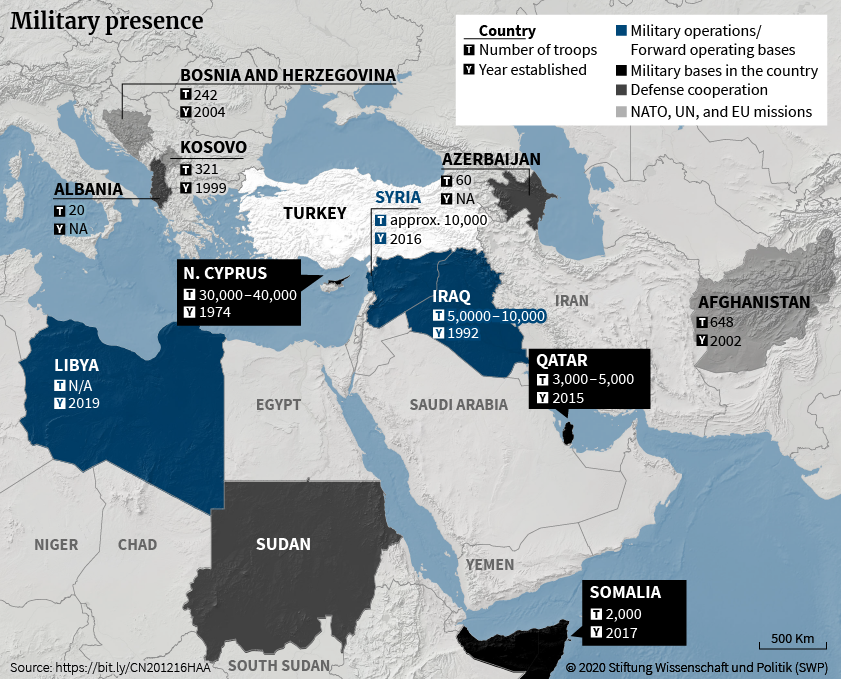
Figure 1: Military presence
Source: Check the Excursus (The dates and numbers in this figures are collected from a variety of sources. The same information is also used in different tables in the Excursus.)
The Turkish leadership has the vision of developing the country into a regional power and making it one of the centers of an emerging multipolar global order. In order to achieve regional power status, Turkey is not only emphasizing its economic power and potential, but also enhancing it military activism and capabilities. The increase in the number of overseas military bases serves this vision of regional power. In recent years, Ankara has established several additional military bases in neighboring regions, especially in the Middle East and Africa.
Even as Ankara projects more power in the Middle East, Eastern Mediterranean, and Africa through its military bases, it is also directly engaging Turkey’s rivals in the Middle East. It is currently conducting military operations in Syria, Iraq, and Libya and maintaining forward operating bases in all of them. Considering these developments, the militarization of Turkish foreign and security policy will continue over the long term. As experts and pundits claim, Turkey is likely to establish even more naval bases, and it is highly interested in expanding the market for its quite successful defense industry.
Here is a list of the different military bases shown in the map in Figure 1 as well as short informative texts about each.
Often dubbed the “second largest army of NATO,” the Turkish military has a long history of trans-border military engagements. Prior to the Arab uprisings, all Turkish trans-border military operations – except in Cyprus and partly in northern Iraq – had been conducted within the context of NATO and UN missions. Today, Syria and Libya constitute the main battlegrounds where the Turkish army is unilaterally involved, in addition to its decades-long military presence in Cyprus and dozens of military bases scattered across northern Iraq. Below, there are detailed maps illustrating the military situations in Syria, Libya, Iraq, and Cyprus/Eastern Mediterranean, followed by short informative texts.
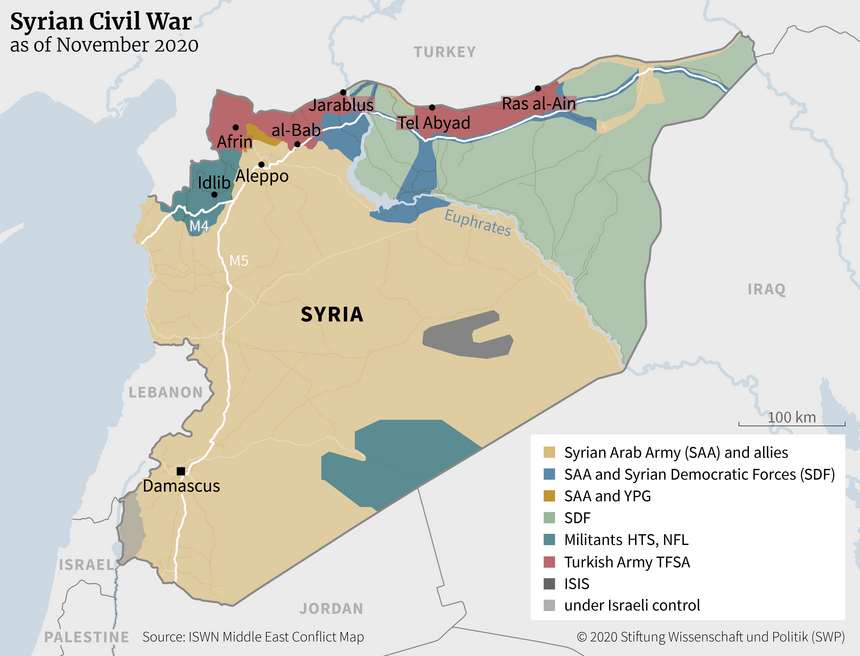
Figure 2: Syrian Civil War
Source: ISWN Middle East Conflict Map
At the start of the uprisings in Syria, Turkey took a firm position and called for the resignation of Syrian President Bashar al-Assad. It also pursued an open-door immigration policy toward the Syrians fleeing the civil war. Ankara also provided a safe haven for the Free Syrian Army and several other military groups fighting against the Syrian regime. There had been frequent criticisms that this hospitality was also extended to armed jihadi groups. Although Turkey rejected the accusation of offering jihadi groups patronage, it officially supported the Free Syrian Army and initiated programs such as “train and equip” (egit-donat) with US support. However, despite this open stance, Turkey refrained from establishing a military presence in the Syrian quagmire until 2016.
Over the course of the Syrian civil war, Turkey’s objectives and the nature of its involvement have evolved. Although toppling the Assad regime was the main priority in the early years, Turkey increasingly came to accept the continuation of the Assad regime. It shifted focus to the prevention of the formation of an autonomous Kurdish political structure and a new flow of refugees toward Turkey. To meet these aims, Turkey has conducted four military operations inside Syria since 2016 to secure four areas under Turkish control:
| Operation | Target | Start Date |
|---|---|---|
| Euphrates Shield | targeting the al-Bab region | 24 August 2016 |
| Olive Branch | targeting the Afrin region | 20 January 2018 |
| Peace Spring | targeting the region between Ras al-Ayn and Tel Abyad | 9 October 2019 |
| Spring Shield | targeting the Idlib region | 27 February 2020 |
Sources: Own compilation
Currently, almost a quarter of the Syrian population is living in territories controlled either by Turkey or its proxies – one of which is the Idlib region in northwest Syria. Turkey is attempting to keep Idlib as a “safe zone” controlled by regime opponents. Currently, Hayat Tahrir al-Sham (HTS) – recognized as a terrorist group by Europe and the United States as well as Turkey – is the primary paramilitary group in Idlib. However, its survival in the region is dependent on Turkish support. Although fighting in Syria has practically ceased in most regions, Idlib remains the last stronghold of the opposition and a stage for future military clashes. In March 2020, Turkey and Russia agreed to establish a security corridor 6 km to the north and 6 km to the south of the M4 highway, which passes through the Idlib region, with joint Turkish-Russian patrols along this section of the highway.
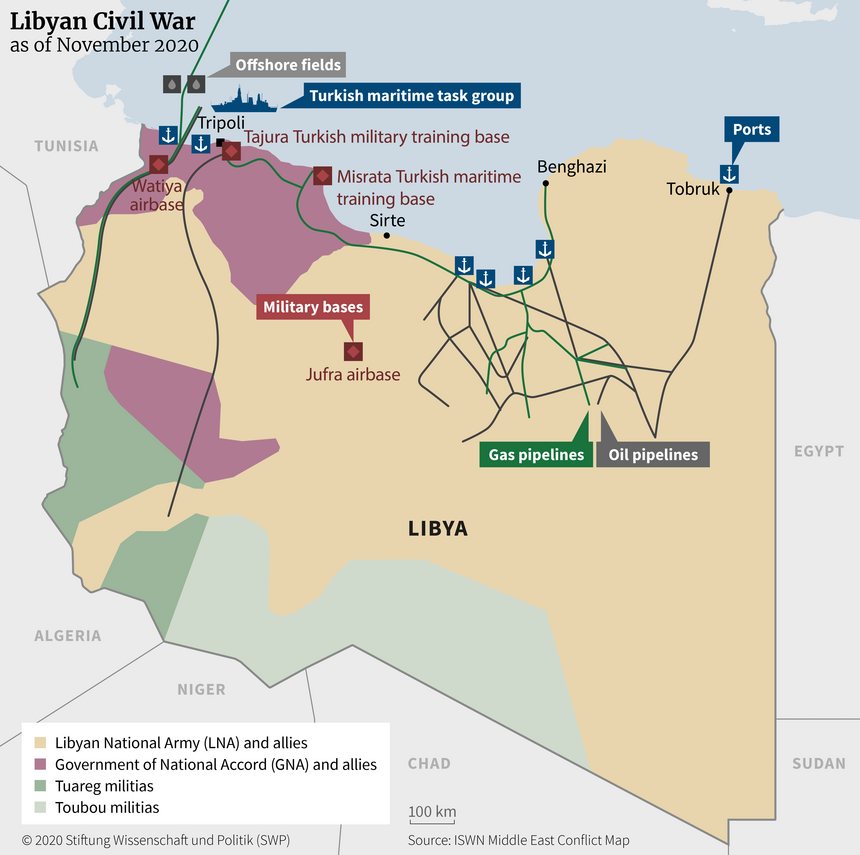
Figure 3: Libyan Civil War
Source: ISWN Middle East Conflict Map
Turkey was a latecomer to the military conflict in Libya. Direct military engagement by Turkey in Libya only began in 2019, to protect the UN-recognized (Government of National Accord) GNA government against General Khalifa Haftar’s military offensive. Turkey recognized the GNA in Tripoli under Fayez al-Serraj and, in line with the relevant UN resolutions, considered it to be the legitimate government of the country whereas its adversary – the renegade Haftar – was supported by a broad coalition comprised of the United Arab Emirates (UAE), Egypt, France, and Russia. Turkey’s interest in intervening in Libya is deeply connected with its ambitions in the Eastern Mediterranean. Isolated in the Eastern Mediterranean, Turkey found an ally in the beleaguered Tripoli government. The two parties signed a Memorandum of Understanding regarding the maritime borders in November 2019 in exchange for Turkish military support for the GNA government. In this context, Turkey has thus far deployed Unmanned Aerial Vehicles/drones, armored vehicles, as well as military personnel and intelligence officials in a training and advisory role to Libya. In this context, Turkey has established five training centers in order to train Libyan forces for combat, air defense systems, mortar firings, annihilation of mines and improvised explosives, forward observation, naval training and so on. Also, the Turkish Maritime Task Group is serving in the Libyan offshore to conduct Search and Rescue operations together with Libyan authorities.
As many sources have claimed, Turkey also transferred mercenaries from Syria to Libya. The UN estimated that there were at least 20,000 foreign fighters and mercenaries in Libya fighting on the both sides and 4,000 Syrian fighters operating under the command of GNU-affiliated forces. Despite the official arms embargo by the UN and the EU, both parties in the conflict continue to receive arms and fighters. However, Turkey is openly sending armaments and personnel, maintaining that it is responding to a call made by the legitimate government of the country, while also claiming that its adversaries are illegally deploying arms.
On 5 February 2021, the Government of National Unity (GNU) was appointed by the Libyan Political Dialogue Forum through a UN-facilitated process aimed at the reunification of state institutions and an election on 24 December. The inauguration of the new interim government did not cause a trenchant change in Turkey's military presence in Libya. The GNU and Ankara have reiterated their commitment to the agreements signed between Turkey and the GNA.
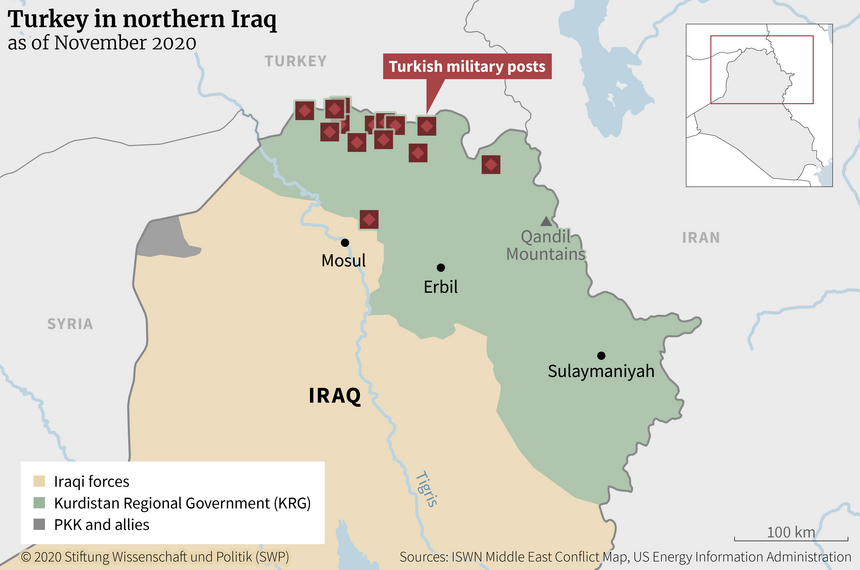
Figure 4: Turkey in northern Iraq
Since the 1990s, the Turkish military has conducted dozens of cross-border operations against bases of the Kurdistan Workers’ Party (PKK) inside Iraq and maintains permanent military facilities in the north of the country. These bases, which mostly stretch along the Turkish-Iraqi border, were set up through a mutual agreement between Turkey and the Iraqi Kurdistan Regional Government (KRG).
Unlike in Syria, Turkey does not control any territory in Iraq. However, by establishing a series of military bases along the Turkish-Iraqi border, it creates a de facto zone. Although it is not militarily feasible to target the main PKK camps in and around the Qandil Mountains from these bases due to the harsh terrain (and also, the Qandil Mountains are located deep in the south and far from the immediate Turkish-Iraqi border), by establishing several military bases, Turkey has created a buffer zone between the PKK forces and its own territory.
Another important military base is far to the south near the town of Bashiqa, which is close to the city of Mosul and the border that delineates the KRG and the central Iraqi government. This base was set up in 2015 in response to the spread of ISIS with the aim of training Kurdish Peshmerga and Sunni Arab fighters. In the wake of the operations to recapture Mosul from ISIS, the Iraqi central government demanded that Turkey evacuate the Bashiqa base, which Turkey refused to do. Turkey argued that the base was built at the request of the (former) Mosul governor through a mutual agreement between the KRG and Turkey. The Iraqi central government continues to demand that Turkey suspend its military operations on Iraqi soil, even though there has been a significant tone down recently.
The Turkish military is involved in hot conflicts in Syria, Libya, and Iraq, but the contexts and objectives differ significantly in each. The Table 2 offers an overview of these differences.
| Iraq | Syria | Libya | |
|---|---|---|---|
| Allies | Kurdish Peshmerga and Sunni Arab fighters | Insurgents | UN-recognized government |
| Adversaries | PKK | The Syrian regime PYD | Khalifa Haftar and allies (supported by a broad coalition with the UAE, Egypt, and France) and House of Representatives (HoR) |
| Content of support | Approximately 2,500 troops | Boots on the ground: 5,000-10,000 | Aerial, intelligence, and training support Syrian mercenaries as proxy forces Maritime search and rescue operations |
| Financial sources | Turkey's own resources | Turkey's own resources | The Libyan treasury (not officially acknowledged) |
| Territorial control | Several military bases scattered across northern Iraq | Large swathes of territories in the north | No territorial control |
| Military presence since | 1992 | 2016 | 2019 |
Sources: Own compilation
As Cyprus faced the imminent end of British control, envoys from the United Kingdom, Greece, and Turkey met to agree upon the political future of the island in 1959. The involved parties established a bi-communal state – the Republic of Cyprus – that was based on power-sharing between Greek and Turkish Cypriots. Considering the prior intercommunal strife and potential conflicts between the two communities, Greece, the United Kingdom, and Turkey appointed themselves as guarantor powers. They declared to safeguard “the independence and territorial integrity of the Republic of Cyprus, and not to promote the unification of Cyprus with other states or partition of the Island” (UN, No 5475 Treaty of Guarantee, 16 August 1960).
In July 1974, Turkey invoked the Treaty of Guarantee and staged a military intervention in Cyprus following a coup by Greek and Greek Cypriot forces, which had taken control and aimed to unite the island with Greece. In August 1974, Turkey launched a second incursion, capturing 38 per cent of the island. Working toward the establishment of separate government structures in the Turkish-held territories, Turkey violated its obligations as a guarantor power for the Republic of Cyprus. Since then, the island has been split into a southern territory controlled by the internationally recognized Republic of Cyprus, and a northern territory administered by the Turkish Cypriots and safeguarded by Turkish military forces. Turkey’s incursion created a diplomatic crisis over the partitioning of the island that lasts till today.
Regarding efforts for reunification, the UN produced the Annan Plan in 2004, which aimed to allow a united and independent Cyprus to become a member state of the EU. To this day, it is the most comprehensive attempt at a solution ever made. But the Greek Cypriots rejected the plan in a referendum – which was approved by the Turkish Cypriots – thus a settlement could not be reached. In the same year, the Greek Cypriots joined the EU, whereas the Turkish Cypriots remained in their non-recognized breakaway state in the north. Between 2014 and 2017, there was another round of intensive peace talks on Cyprus in the Swiss mountains of Crans Montana in July 2017, but the negotiations failed. In October 2020, Turkish Cypriots with the support of Turkey opened the gates of the restricted area of Varosha, a former tourist hub in the Turkish-occupied north of the island. As part of Turkey’s expansionist strategy in the Eastern Mediterranean, Ankara shifted its focus toward the final division of the island.
Both the geostrategic importance of Cyprus in the Mediterranean and the existence of an ethnic Turkish community on the island account for the continued attention that Turkish political elites pay to the island.
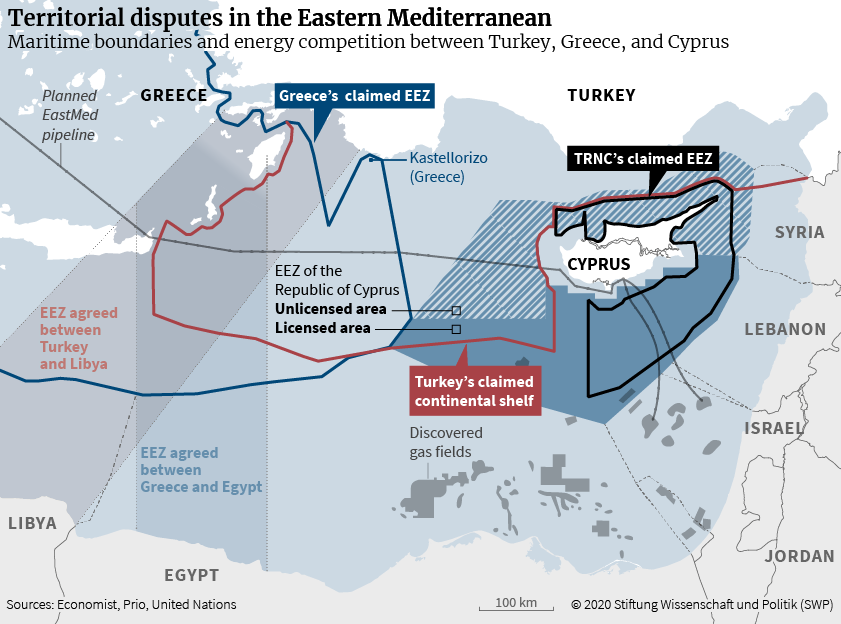
Figure 5: Territorial disputes in the Eastern Mediterranean. Maritime boundaries and energy competition between Turkey, Greece an Cyprus
Sources: Economist, Prio, United Nations
The Eastern Mediterranean has become a flashpoint for maritime boundary conflicts, competing drilling activities, international naval exercises, and bellicose statements in recent years. Because of Turkey’s ambitious aspirations and strong military footprint, its actions are indicative of new security imperatives and shifting balances of power in the region.
Ankara’s – actual and potential – unilateral offshore drilling activities in disputed areas in the region are fueling the growing hostilities between Turkey, Greece, and Cyprus, adding another layer of tension to the already contested EU-Turkey relationship.
Turkey’s claimed continental shelf partly overlaps with the exclusive economic zone (EEZ) of the Republic of Cyprus, as it was defined via bilateral agreements between Nicosia and Cairo as well as Nicosia and Tel Aviv. In summer 2020, Turkey conducted research and drilling in areas that Greece has declared to be part of its own EEZ. Turkey is proactively challenging the legitimacy of Greece’s EEZ, as defined in bilateral agreements between Athens and Rome, and Athens and Cairo.
Turkey has signed two maritime boundary delimitation agreements:
21 September 2011 Continental Shelf Delimitation Agreement Between Turkey and “TRNC” (internationally non-recognized Turkish Republic of Northern Cyprus)
27 November 2019 Turkey-Libya Memorandum of Understanding on Delimitation of the Maritime Jurisdiction Areas in the Mediterranean (signed between the Government of the Republic of Turkey and the Government of National-Accord State of Libya)
Turkey has granted a number of licenses to the Turkish Petroleum Corporation (TPAO) to search for offshore energy resources in large parts of its claimed continental shelf – including disputed areas – in recent years. In May 2018, TPAO started with offshore drilling activities in the Eastern Mediterranean and, since May 2019, has also been drilling in the EEZ of the Republic of Cyprus.
Areas of tension:
TPAO’s drilling activities inside the EEZ of the Republic of Cyprus
TPAO’s drilling activities inside the EEZ of the Republic of Cyprus in areas that have been awarded to ENI (Italy) and TOTAL (France)
TPAO’s seismic surveys in an offshore area near Crete and close to the island of Kastellorizo, which is claimed by Greece as part of its EEZ
These drilling activities stopped in December 2020, right before the EU’s announcement of upgrading sanctions that were imposed in August 2020. Following this, Greece and Turkey sat down for exploratory talks to discuss their concerns in the region
Turkey’s power projection in the Eastern Mediterranean is based on a new security doctrine promoting a relatively new strategy of forward defense. According to the doctrine, the security of mainland Anatolia relies on the presence of Turkish troops being stationed beyond its national borders, namely northern Iraq, Syria, and more recently, Libya. The Mavi Vatan (“Blue Homeland”) doctrine has extended the concept to the seas. Hence, Turkey’s claimed continental shelf, which stretches from the Black Sea across the Aegean to the Eastern Mediterranean, constitutes a maritime sphere of influence that must be protected.
* An earlier version of this paragraph had been previously published in the APSA MENA newsletter.
Without the cumulative growth of the Turkish defense industry over the last four decades, a pronounced shift to a hard-power approach would not have been possible. If the US arms embargo following Turkey’s invasion of Cyprus in 1974 was the first moment when Ankara realized the importance of having a defense industry to protect its national interests, the end of the Cold War underlined the necessity for an independent defense sector. Building on these earlier developments, the Turkish defense industry continued to grow rapidly under the rule of the Justice and Development Party (AKP). Between 2010 and 2019 – a period that overlapped with the seeming “soft power” era of Turkey – Turkish military expenditures increased steadily by 86 per cent. Aviation and defense exports significantly increased during the same period (see Figure 7). Today, around 60 percent of the aviation and defense inventory of the Turkish Armed Forces is produced domestically. The impressive improvements evidently are a source of pride for the government. At public events, for instance, politicians often praise the drones that have been produced domestically by Baykar Savunma – a firm owned by the family of President Erdoğan’s son-in-law, Selçuk Bayraktar – and by Turkish Aerospace Industries. The latter was established in 1984 as a joint venture between Turkish and US partners, and it was restructured in 2005, when Turkish partners acquired the shares of foreign investors. Turkish drones have attracted international attention in the last few years, especially following their deployment in Syria and Libya. The Turkish navy has also been an important pillar of Ankara’s power aspirations in recent years, evidenced in particular through the simultaneous maneuvers in the Eastern Mediterranean, the Aegean, and the Black Sea. Turkey is significantly upgrading its navy through modernization projects, which are mostly being carried out by Turkish contractors. Moreover, more than 20 war ships – including one amphibious assault ship (LHD) – will be added to the navy’s fleet in the next three years. In short, the growth over time of an indigenous defense industry and – equally if not more important – the sense of power that it has reinforced in Ankara enables a more aggressive stance and readiness for military action in multiple spheres.
Figures 6, 7, and 8 delineate how Turkey’s military expenditures and defense industry have developed in recent years.
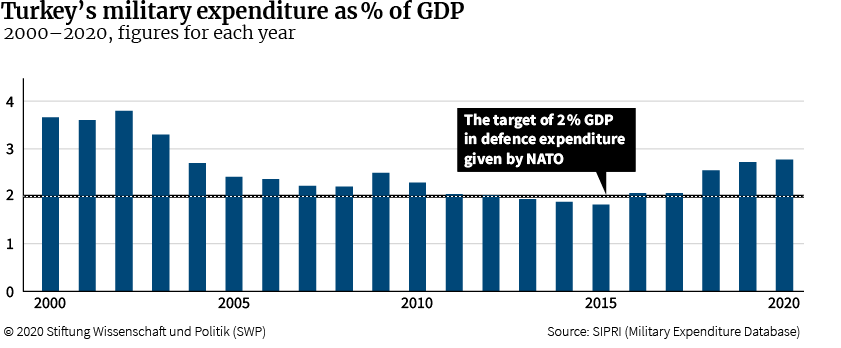
Figure 6: Turkey's military expenditure as % of GDP, 2000–2019
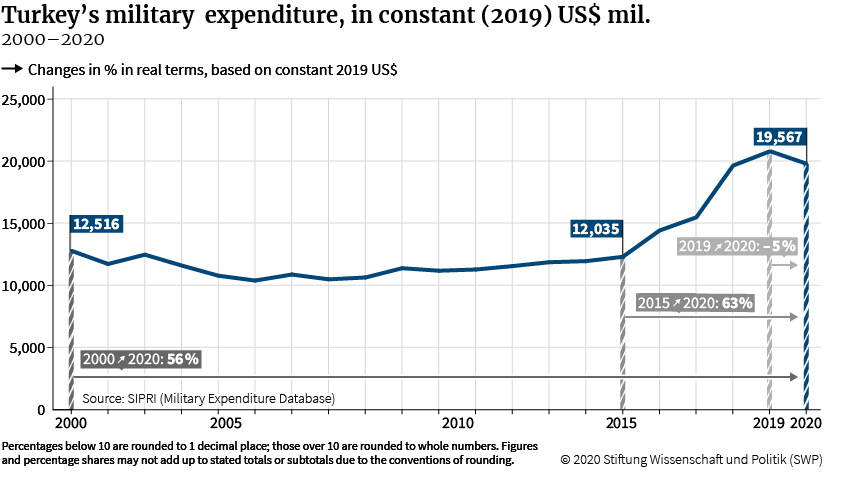
Figure 7: Turkey's military expenditure, in constant (2018) US$ mil.
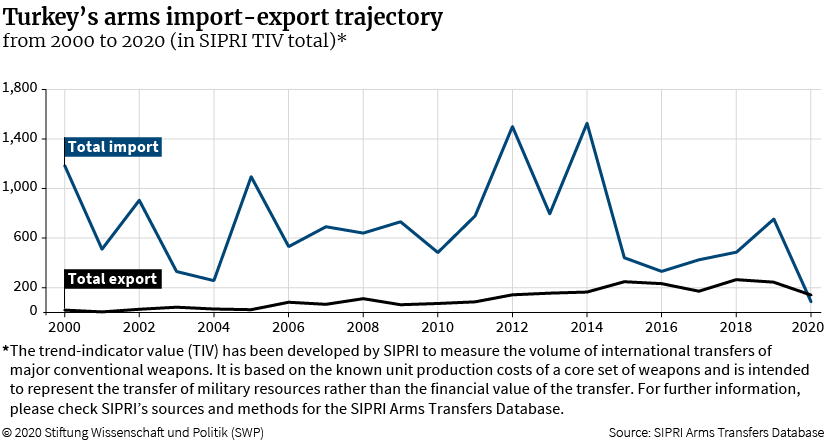
Figure 8: Turkey's arms import-export trajectory
The sharp decline in Turkey’s arms imports in 2020 is partly due to the increase in domestic production and partly due to the impact of an official and non-official arms embargo applied by the US and other Western countries. In fact, the embargo is one of the reasons for the boost in domestic production and might have created a counter impact in the short term. But on the other hand, the embargo might hinder the import of equipment for arms production and have more concrete results in the long run.
Source: SIPRI (Arms Transfers Database)
Although Turkey’s deployment of its military in foreign affairs has attracted significant attention lately, there are other important dimensions of Turkish foreign policy activism, such as multilateral engagements with international organizations and the provision of large-scale development aid. Figure 9 provides a timeline illustrating Turkey’s engagement with international organizations. Figure 10 shows the overseas offices of the Turkish Cooperation and Coordination Agency (TİKA) – Turkey’s main agency for the provision of development aid – as well as the top recipient countries. Figure 11 provides information on the scale and evolution of development aid over the last 10 years.
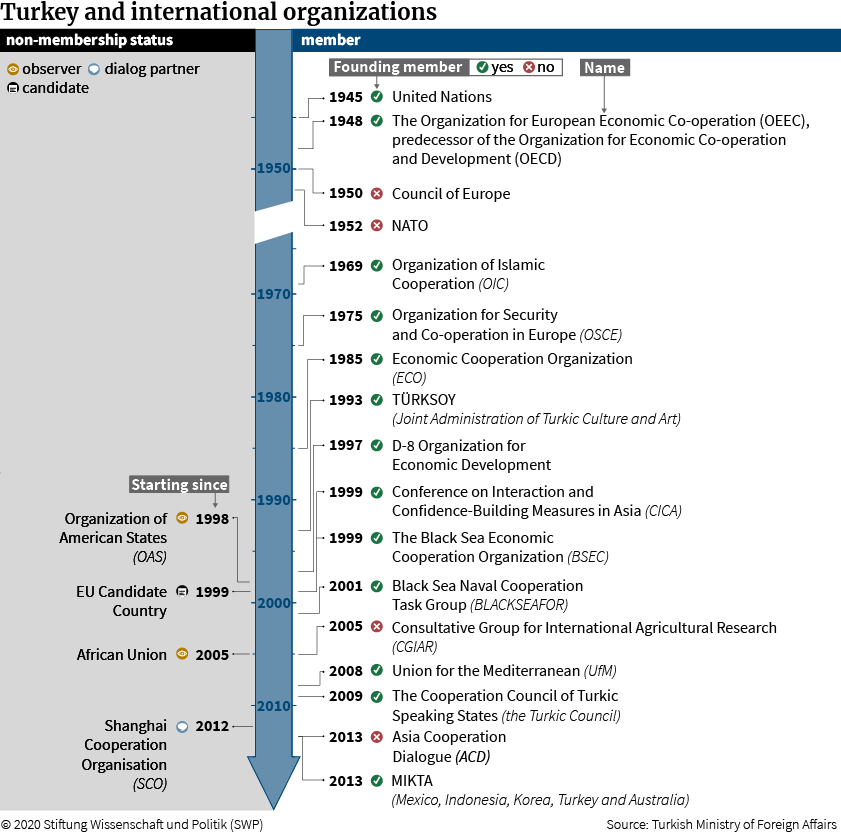
Figure 9: Turkey and international organizations
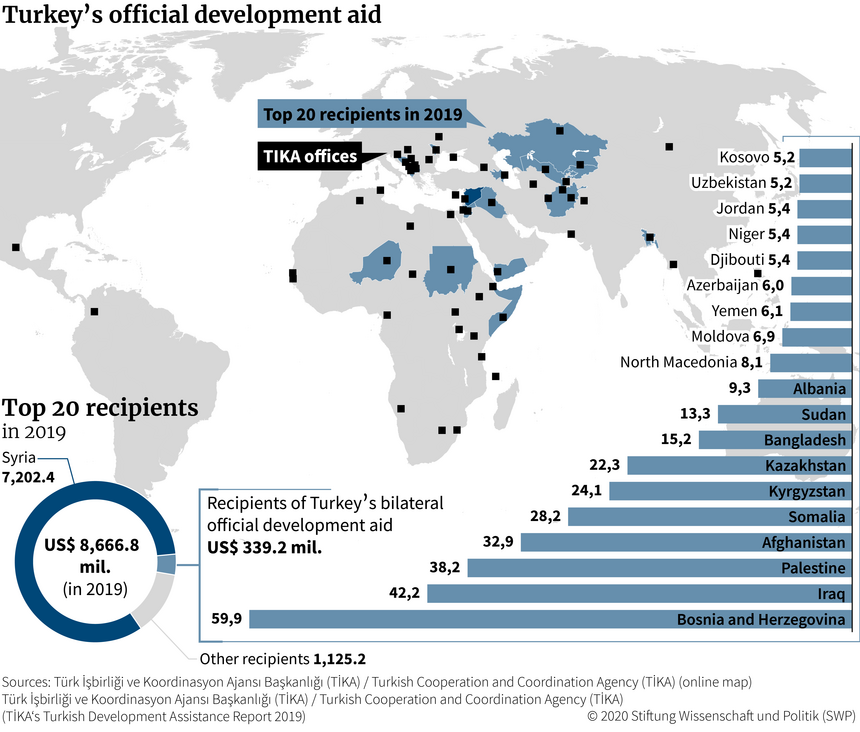
Sources: Türk İşbirliği ve Koordinasyon Ajansı Başkanlığı (TİKA) / Turkish Cooperation and Coordination Agency (TİKA) (online map), Türk İşbirliği ve Koordinasyon Ajansı Başkanlığı (TİKA) / Turkish Cooperation and Coordination Agency (TİKA) (TİKA‘s Turkish Development Assistance Report 2018)
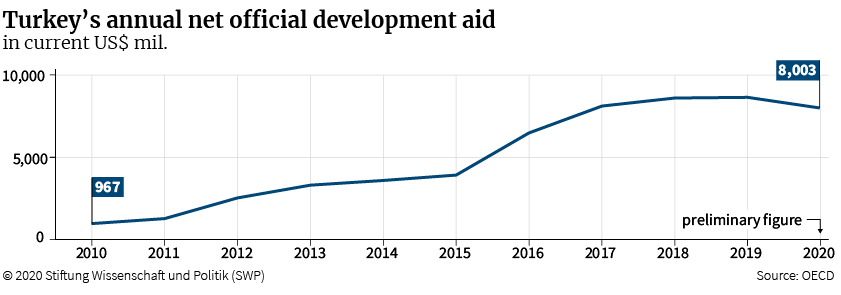
Figure 11: Turkey's annual net official development aid
Source: OECD